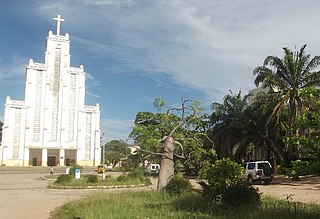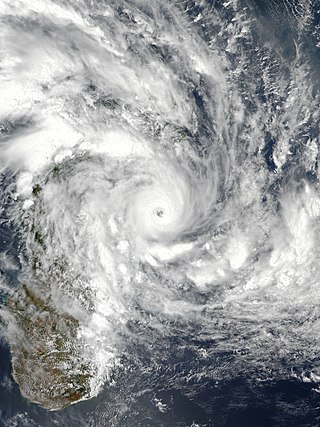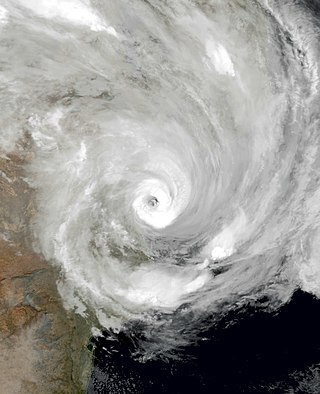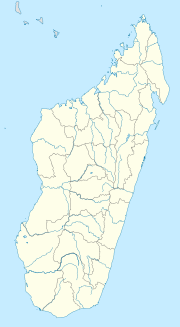
Mahajanga[maːˈdzaŋɡə̥] is a city and an administrative district on the northwest coast of Madagascar. The city of Mahajanga is the capital of the Boeny Region. The district had a population of 220,629 in 2013.

Very Intense Tropical Cyclone Gafilo was both the most intense tropical cyclone ever recorded in the South-West Indian Ocean and the most intense tropical cyclone worldwide in 2004. Being unusually large and intense, Gafilo was the deadliest and most destructive cyclone of the 2003–04 South-West Indian Ocean cyclone season. According to the EM-DAT International Disaster Database, Gafilo killed at least 363 people. Gafilo also caused about $250 million damages in Madagascar, which makes it one of the most devastating storms to hit the country on reliable record.

Intense Tropical Cyclone Leon–Eline was the second longest-lived cyclone in the Indian Ocean, behind Cyclone Freddy, traveling over 11,000 km (6,800 mi) during its 29-day track through the Indian Ocean, throughout the entire month of February. The cyclone formed on 1 February 2000, in the Australian basin as Tropical Cyclone Leon, and was renamed Eline after crossing 90° E into the South-West Indian Ocean; there, the Météo-France office in Réunion (MFR) tracked the storm's movement and intensity. Late on 17 February, Eline made landfall near Mahanoro, Madagascar, with 10‑minute winds of 165 km/h (103 mph). The storm rapidly weakened over land, but restrengthened in the Mozambique Channel to reach peak 10‑minute winds of 185 km/h (115 mph), making it an intense tropical cyclone. On 22 February, Eline made landfall about 80 km (50 mi) south of Beira, Mozambique, near peak intensity. Eline quickly weakened over land as it moved across Southern Africa, finally dissipating over eastern Namibia on 29 February.

Vatomandry is a town in and the administrative center of the Vatomandry District, Atsinanana Region, Madagascar. An airport serves the city.

The 2002–03 South-West Indian Ocean cyclone season was one of the longest lasting and the third-most active season in the South-West Indian Ocean. Storms during the season impacted the Mascarene Islands, Seychelles, Madagascar, and countries in south-eastern Africa. The season began early when an unnamed tropical storm struck Seychelles in September, becoming the most damaging storm there in 50 years. The next system, Atang, was the first named storm of the season, but was only a tropical depression; it was named due to the threat to an outer island of Mauritius. Atang later struck Tanzania in a climatologically unusual area in November, resulting in unconfirmed deaths of fishermen. The first named storm to reach tropical storm intensity was Boura, which brushed the Mascarene Islands with gusty winds and rainfall. In December, Cyclone Crystal threatened to strike Mauritius but instead veered eastward, and later, Tropical Storm Delfina lasted from late December through early January 2003. Delfina damaged or destroyed thousands of houses in Mozambique and Malawi, killing 54 people.
The Roman Catholic Archdiocese of Toamasina is one of five Latin Metropolitan archdioceses on Madagascar, yet depends on the missionary Roman Congregation for the Evangelization of Peoples.

Intense Tropical Cyclone Ivan was a powerful tropical cyclone that struck Madagascar in February 2008. Forming from a persistent area of convection on 7 February, Ivan initially tracked southeastward, before looping to the west-southwest. Encountering favourable conditions, it strengthened to attain peak winds on 17 February before striking northeastern Madagascar. It degenerated into a remnant low pressure area as it crossed the island, and briefly re-organized into a weak tropical depression before dissipating on 22 February.

The 2011–12 South-West Indian Ocean cyclone season was a slightly above average event in tropical cyclone formation. It began on November 15, 2011, and ended on April 30, 2012, with the exception for Mauritius and the Seychelles, for which it ended on May 15, 2012. These dates conventionally delimit the period of each year when most tropical cyclones form in the region; however, Severe Tropical Storm Kuena developed in early June, after the season had officially ended. The basin is defined as the area west of 90°E and south of the Equator in the Indian Ocean, which includes the waters around Madagascar westward to the east coast of Africa. Tropical cyclones in this basin are monitored by the Regional Specialised Meteorological Centre in Réunion.

Intense Tropical Cyclone Giovanna was a powerful tropical cyclone that affected Madagascar. Giovanna was the ninth tropical depression, seventh named storm and third tropical cyclone of the 2011–12 South-West Indian Ocean cyclone season. Giovanna was blamed for 35 deaths along the Madagascar coast, La Réunion, and Mauritius, and it was the first intense tropical cyclone to impact Madagascar since Cyclone Bingiza one year earlier.

Tropical Cyclone Manou was a relatively rare May tropical cyclone that affected southeastern Madagascar. The final named storm of the 2002–03 South-West Indian Ocean cyclone season, Manou formed on May 2 to the southwest of Diego Garcia. It moved generally to the southwest for much of its duration, steered by a ridge to the southeast. Manou affected Saint Brandon and Mauritius with gusty winds. After an initial strengthening phase, the storm weakened but later re-intensified as it approached Madagascar. Manou developed a well-defined eye and reached peak winds only 19 km (12 mi) from the eastern Madagascar coastline. For about 12 hours, the cyclone stalled before turning to the south and weakening. Manou became extratropical on May 10 and dissipated three days later.

In early 2000, severe flooding occurred in the African nation of Madagascar after Cyclone Leon–Eline and Severe Tropical Storm Gloria struck the nation within a two-week period. The first storm, Eline, formed on February 1, and took an extended track across the Indian Ocean, eventually making landfall near Mahanoro on February 17. On March 1, Gloria struck northeastern Madagascar, and like Eline, moved southwestward across the country.

Tropical Cyclone Ava was a strong tropical cyclone that brought devastating impacts to parts of eastern Madagascar in January 2018. The first tropical depression, first named storm, and first tropical cyclone of the 2017–18 South-West Indian Ocean cyclone season, Ava formed as a weak area of disturbed weather well northeast of St. Brandon on December 30. Monitored by Météo-France La Réunion (MFR), the disturbance drifted southwest, before intensifying to a moderate tropical storm on January 2. Ava drifted south afterwards with little change in strength; then among favorable conditions near the coast of Madagascar Ava rapidly intensified to tropical cyclone intensity by early on January 5 shortly before making landfall in eastern Madagascar. After landfall, Ava pummeled the region with rainfall and flooding as it weakens into a moderate tropical storm. Ava exited the landmass on January 7 and became post-tropical southeast of southern Madagascar on January 8, slowly drifting southwards as a vigorous low before dissipating a day later.

Intense Tropical Cyclone Herold was a powerful tropical cyclone that affected Madagascar and the Mascarene Islands in March 2020. Herold was the tenth zone of disturbed weather, ninth depression, eighth moderate tropical storm, sixth severe tropical storm, fifth tropical cyclone, and second intense tropical cyclone of the slightly above-average 2019–20 South-West Indian Ocean cyclone season. Herold formed on 13 March from a disorganized area of low pressure near Tromelin Island.

Tropical Cyclone Eloise was the strongest tropical cyclone to impact the country of Mozambique since Cyclone Kenneth in 2019 and the second of three consecutive tropical cyclones to impact Mozambique in the 2020–21 South-West Indian Ocean cyclone season. The seventh tropical depression, fifth named storm and the second tropical cyclone of the season, Eloise's origins can be traced to a disturbance over the central portion of the South-West Indian Ocean basin which developed into a tropical depression on 16 January, and strengthened into a tropical storm on 17 January, though the storm had limited strength and organization. On the next day, the storm entered a more favorable environment, and it soon intensified to a severe tropical storm on 18 January. Late on 19 January, Eloise made landfall in northern Madagascar as a moderate tropical storm, bringing with it heavy rainfall and flooding. The storm traversed Madagascar and entered the Mozambique Channel in the early hours of 21 January. After moving southwestward across the Mozambique Channel for an additional 2 days, Eloise strengthened into a Category 1-equivalent cyclone, due to low wind shear and high sea surface temperatures. Early on 23 January, Eloise peaked as a Category 2-equivalent tropical cyclone on the Saffir–Simpson scale as the center of the storm began to move ashore in Mozambique. Shortly afterward, Eloise made landfall just north of Beira, Mozambique, before rapidly weakening. Subsequently, Eloise weakened into a remnant low over land on 25 January, dissipating soon afterward.
Ilaka Est is a rural municipality located in the Atsinanana region of eastern Madagascar, and belongs to the Vatomandry (district).
Tsivangiana is a rural municipality located in the Atsinanana region of eastern Madagascar, and belongs to the Vatomandry (district).

Ifasina I is a small village and commune in the Vatomandry District, in Atsinanana, Madagascar.
Ifasina III is a rural municipality located in the Atsinanana region of eastern Madagascar, and belongs to the Vatomandry (district).
Ifasina II is a rural municipality located in the Vatomandry district of the Atsinanana region of eastern Madagascar.

Intense Tropical Cyclone Batsirai was a deadly tropical cyclone which heavily impacted Madagascar in February 2022, becoming the strongest tropical cyclone to strike Madagascar since Cyclone Enawo in 2017. It made landfall two weeks after Tropical Storm Ana brought deadly floods to the island country in late January. The second tropical disturbance, the first tropical cyclone, and the first intense tropical cyclone of the 2021–22 South-West Indian Ocean cyclone season, Batsirai originated from a tropical disturbance that was first noted on 24 January 2022. It fluctuated in intensity and became a moderate tropical storm on 27 January 2022, after which it unexpectedly rapidly intensified into an intense tropical cyclone. It then weakened and struggled to intensify through the coming days due to present wind shear and dry air, where it weakened after some time. Afterward, it entered much more favorable conditions, rapidly intensified yet again to a high-end Category 4 cyclone on the Saffir–Simpson scale while moving towards Madagascar. The storm underwent an eyewall replacement cycle the next day, and fluctuated in intensity before making landfall in Madagascar as a Category 3 cyclone, later rapidly weakening due to the mountainous terrain on the island.
















